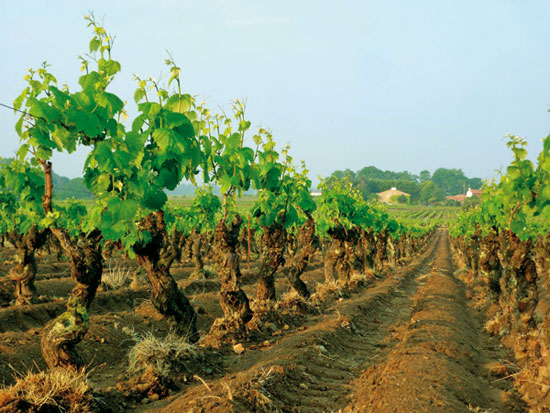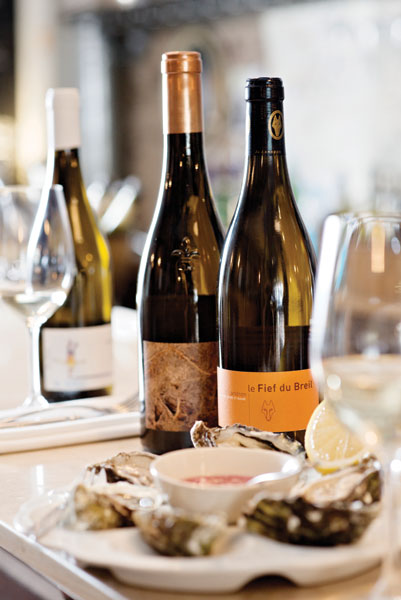Muscadet fell out of fashion 20 years ago, but today it's all the rage, thanks to a handful of quality-conscious producers who are raising the bar. Christelle Guibert tours the region and likes what she sees — and tastes.
I have been very fortunate as tastings director at Decanter to travel the world and to visit and marvel at its many wine regions. My most recent trip proved no exception and turned into one of the most inspiring assignments I’ve had in the past few years. I wasn’t dispatched to the magnificent Douro Valley or the spectacular vineyards of Argentina’s Andean foothills, but rather to Muscadet at the western end of the Loire Valley, not far from where I grew up.
Like most British consumers, over the past 20 years the French (myself included) have turned their noses up at Muscadet. But a visit to this unloved region was a real eye-opener. Muscadet, it turns out, hasn’t given up the ghost just yet and is in urgent need of re-evaluation.
Trends are nothing new in wine. Today’s Picpoul effect is simply yesterday’s Pinot Grigio craze. But 30 years ago it was Muscadet that was all the rage. As Marc Pesnot of Domaine de la Sénéchalière recalls, ‘The Muscadet phenomenon was like a tsunami: one day we were on top of the world but we lost everything almost overnight.’
In the 1980s exports were booming and demand was sky high. As in other regions of France, which would ultimately suffer as a result, producers took advantage of chemical fertilisers, herbicides, pesticides or whatever was needed to produce large quantities of basic white wine for négociants to sell to an unsophisticated British market. Marc Ollivier, from Domaine de la Pépière, remembers that the Muscadet vineyard went from 10,000 hectares to 13,000ha in a very short time. ‘New vineyards were planted on land unsuitable for vines,’ he says.
This approach proved unsustainable. By the early 1990s, wines from the New World were outmuscling those from the Old, and Muscadet’s decline was setting in. The region would see exports fall by almost half in less than a decade.
Of course, trends aren’t everything. Its location so close to the Atlantic Ocean means that growing conditions can be challenging. Frost, mildew, coulure (failure of grapes to develop) and millerandage (bunches of uneven ripeness and maturity) are very unforgiving. In 1991, the region suffered from severe frost, resulting in a tiny harvest. Pressures of demand led some producers to release mediocre wines from surplus stock and to increase prices to compensate for the loss of volume. Such unscrupulous behaviour did little to help Muscadet’s image.
More recently, in 2008 almost 60% of the production was lost to another severe frost, but a low tolerance for high prices and poor quality has meant many Muscadet producers have gone out of business. According to Charles Sydney, a Loire Valley wine broker, the number of producers is down 50% from the 1980s. Indeed, you only have to visit the region to see how many vineyards with fabulous terroir have been left abandoned.
Grower focus
While many big négociant names have deserted the region, they still account for 75% of Muscadet production. For the majority of growers, low prices and high volume remain the driving forces, but there is a clutch of quality-conscious producers making outstanding wines of real character. Fred Niger Van Herck of Domaine de l’Ecu, who is one of the leading figures in the region, claims that today Muscadet has 650 producers but only 20 of them are proper growers. ‘We sell almost all our wines on allocation. If we can do it, then anyone who makes great Muscadet can do it too,’ he says.
Guy Bossard, the founder of Domaine de l’Ecu, adopted biodynamic methods in the 1980s and has been making terroir-driven cuvées (words not often associated with Muscadet) ever since. So, too, Jo Landron of Domaines Landron, who also converted his vineyards in the 1980s. ‘Producers never looked at what they had under their feet until 10 years ago,’ he confesses. ‘These days we always ask ourselves what we are going to do with each plot – whether to use the grapes for our crus or sell them to négociants. And if we think the plot is not able to produce good Muscadet, we plant grass instead.’
Not all markets have been dominated by négociants, and not all producers have suffered as a consequence. According to Marc Olliver of Domaine de la Pépière, ‘My number one market is the US, where the image of Muscadet hasn’t been affected. There, Muscadet sales are dominated by independent growers, whereas in the UK and France it is very much a negociant market.’
Yet there is tension: spend a week with both négociants and independent growers and you can sense the frustration among the leading producers who are fighting to improve the image of Muscadet as a serious wine. For this group of winemakers, Melon de Bourgogne, from which Muscadet is made, is one of its unique selling points, but the mass-market producers see it as a disadvantage.
Jérôme Bretaudeau of Domaine Bellevue, one of the rare breed of young winemakers in the region, puts it this way: ‘Who else in the world makes Melon de Bourgogne? We have a unique grape variety and a unique terroir with great diversity – what else could we ask for?’
But this purism isn’t shared by all. Recent talk of the addition of Colombard and increasing residual sugar levels have become hot topics. Olivier Mouraud from the négociant Cave de la Nantaise explains that Colombard was historically planted in the region. ‘We believe a small percentage of Colombard will add fruit characteristics to the wine and will make Muscadet more appealing to young consumers,’ he says.

New discoveries
Regardless of which side you take, it is clear that the overall quality of Muscadet has improved dramatically. The bland, green and acidic wines that washed down oysters during summer holidays at three Euros a bottle are now being replaced by riper, more lively and zingy wines made in a brighter style (which are still great with oysters, by the way!).
Pierre-Jean Sauvion of Château du Cléray explains that 2003 was the turning point. ‘It was not a typical vintage, but consumers seemed to enjoy the style. We understood that we had to pick later to have more maturity instead of picking earlier to keep the acidity.’ Ollivier recalls that consumers in the 1980s and ’90s found Muscadet ‘dull and too acidic’. ‘Some producers de-acidified to make their wines softer and used flavoured yeasts to add character to their wines.’ Today, producers have a better understanding of their vineyard; they are picking later when the grapes are fully matured. Yields are lower and winemaking techniques have been refined.
Muscadet’s trademark is the ageing process. After fermentation, the wines are left on their lees (the dead or residual yeast sediment from the alcoholic fermentation) in traditional underground glass-coated tanks, or, more recently, in stainless steel tanks. This process allows wines to develop a fuller mouthfeel, deeper flavours and also adds freshness. The wines are then bottled directly from their lees without racking. To label your wines ‘sur lie’, they have to have spent one winter on the yeast and to have been bottled between 1 March and 30 November, unless the harvest is late, in which case bottling can be postponed accordingly.
Since the early 2000s, the diversity of the region’s terroirs has become increasingly important. With the help of INAO (the French appellations body) and the Muscadet syndicat, producers are working together to focus on sub-regions. Following many carottages (core-samplings), a total of nine different crus communaux in the AC Muscadet de Sèvre et Maine have been identified. The Gorges commune, in the south of the appellation, initiated proceedings and eight more have followed suit. Today, three communes – Gorges, Clisson and Pallet – have been officially certified by INAO as crus communaux and the other six are awaiting recognition.
To make wines labelled crus communaux, producers have to adhere to strict rules in relation to vine age, yield, maturity and ageing on the lees. The concept brings a much-welcome hierarchy to the region but needs fine tuning. Some crus, for example, have adopted a communal label to create stronger brand awareness but this is likely to be at the cost of individual producers having their own signature. Also, you practically need a magnifying glass to read the word Muscadet on the label, which is a pity because, without it, the individual crus become meaningless.
The crus communaux account for just 1% of total production and should be seen as the premier crus of Muscadet (just as the 10 Beaujolais crus are in that region). As such, they can raise the profile of Muscadet and make consumers aware of the importance of terroir.
Serious and stylish
How do the Muscadet crus translate in the glass? Well things have undeniably come a long way from the basic white wines of the 1980s. They are far more complex, with more depth and minerality. They need time to develop in bottle but promise to be extremely food-friendly. A sense of terroir is definitely there, though differences are admittedly subtle for now, but it’s early days yet and distinct personalities will become more obvious with time.
Cru Clisson, for example, a more forward style, displays richness and power. Gorges has more pristine acidity and minerality and will need time to open up. Monnières-St-Fiacre is a more elegant wine with a citrus-fruit profile, while Goulaine displays honey, dried fruit and roundness. Mouzillon Mézières shows nervosity with some herbal notes such as thyme. La Haye-Fouassière has elegance and delicate fruit, while Vallet is more aromatic and fruit driven. Minimum ageing on lees is 17 months for crus communaux, but technically they cannot be called Muscadet Sur Lie – another small glitch that needs addressing.
Patrick Matthews once wrote in his book The Wild Bunch, ‘Cheap versions of wines that should be expensive are almost always disappointing. Expensive versions of underrated ones are usually a revelation.’ This is Muscadet in a nutshell. A serious Muscadet is a serious wine and promises to get better with age. I was lucky enough to taste Muscadet dating back to 1982 during my trip. The freshness, minerality and pristine acidity laced with honey and nutty notes was a revelation. Some even had the eminence of old Chablis or even Meursault. These gems easily rival some of the finest wines in the world and carry a modest price tag of less than £20.
How many white wines are bone-dry, with alcohol levels rarely above 12% and with racy acidity and great ageing potential? Now how many of those can you afford? But decide for yourself: go to your independent wine merchant and stock up on Muscadet, especially the 2012 vintage, which was a great year. Drink some now and cellar the rest to enjoy over the next 20 years. Or if you cannot wait that long and are passing through central London, drop into the Green Man & French Horn bistro – they have an extensive wine list of aged (and younger) Muscadets.
See Guibert’s top 10 Muscadets here
Written by Christelle Guibert







